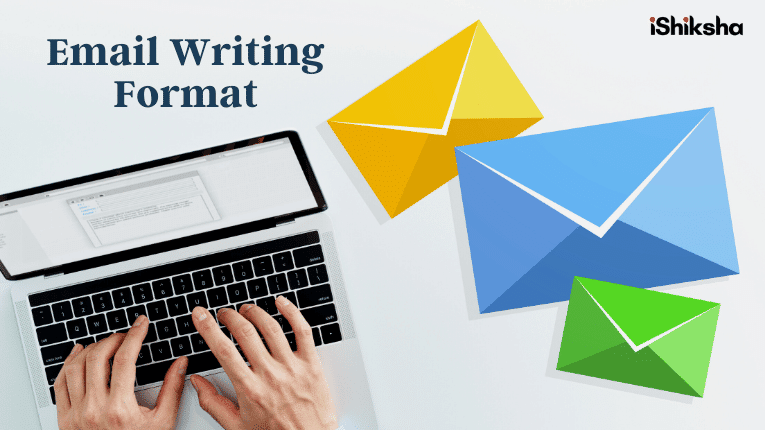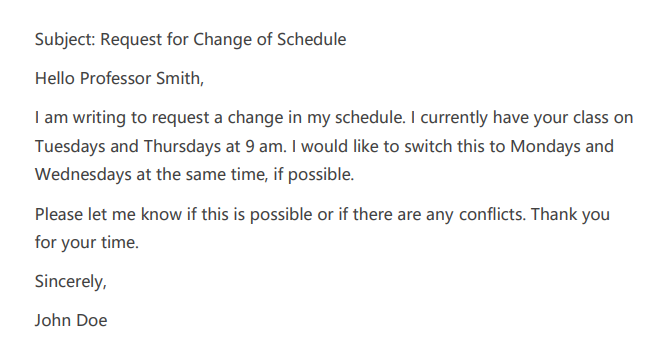Email writing can be an excellent way for students to communicate with their teachers, classmates, and other school officials. However, it’s important to know the proper email writing format to get your message across effectively. Here are some tips for students on how to write an email in a clear, concise, and professional manner.

Email Writing Format
The email writing format is the way you set up your email to communicate with others. It includes things like the subject line, greeting, opening, and closing of your email. Your email format can be formal, semi-formal, or informal, depending on who you are communicating with and the purpose of your email.
Here is what you should include in your email:
1. Subject Line
The subject line of your email should be brief and to the point. It should give the reader an idea of what the email is about. For example, if you’re emailing your teacher about a homework assignment, you might write “Homework question” in the subject line.
2. Greeting
The greeting of your email will depend on who you are writing to and the level of formality. If you are emailing a teacher or other school official, it is generally considered polite to start your email with “Dear ____” followed by their name. For more informal communications, such as emails to classmates, simply starting your email with “Hi” or “Hello” will suffice.
3. Opening and Body
The opening of your email should be brief and get right to the point. You can use a statement about the purpose of your email or ask a question that relates directly to the message you want to convey.
Your body should then expand on this information, providing details and supporting evidence where appropriate. Keep your tone professional and avoid using slang, overly casual language, or emoticons.
4. Closing and Signature
After you have finished writing your email, you will need to sign off with a closing statement. “Sincerely” or “Best” are typical closings for formal emails, while “Thanks” or “Take care” are more appropriate for informal communications. Finally, be sure to include your full name and contact information in your email signature.
Email Writing Format Types
There are three basic types of email writing formats- formal, semi-formal and informal. Let’s understand the difference between them:
Formal Email Format
Formal emails are generally used for business purposes and are written to people we don’t know well or at all. They require a more formal tone and structure than the other two types of email writing formats. When writing a formal email, there are a few things to keep in mind, which include:
- Use a professional, courteous tone.
- Use proper grammar and punctuation.
- Avoid abbreviations and acronyms.
- Keep it concise.
- Include a formal sign-off, such as “Best regards” or “Sincerely.”.
Informal Email Format
Informal emails are used for personal purposes and are generally written to people we know well. They tend to be less formal than the other two types of email writing formats, and as such, there is more flexibility in terms of language and structure. However, there are still some basic guidelines that should be followed when writing an informal email, which includes:
- Use a friendly, conversational tone.
- Avoid abbreviations and acronyms.
- Use proper grammar and punctuation.
- Keep it brief.
- Include a sign-off.
Semi-Formal Email Format
Semi-formal emails are often used for business purposes but can also be used for personal ones. They lie somewhere between informal and formal emails in terms of language and structure. When writing a semi-formal email, it is important to consider the following guidelines:
- Be polite but not overly formal.
- Use correct grammar and punctuation.
- Avoid abbreviations and acronyms if possible.
- Keep the message brief and to-the-point.
- Include a suitable closing statement, such as “Regards” or “Cheers.”.
- Proofread your email carefully before sending it to ensure error-free.
Important Tips for Email Writing Format
Email is the most common form of written communication in the business world today. Because email is so prevalent, it’s important to know how to write it correctly and effectively. Here are some tips on email writing format:
- Use a professional or business-like tone. This means avoiding slang, emojis, and other informal languages in your emails.
- Keep your message concise and to the point. Long, rambling emails are often ignored or misunderstood, so it’s best to keep your messages as brief as possible while conveying your point.
- Always proofread your email before sending it, and check for any grammar or spelling mistakes that could make you seem unprofessional or careless.
- If you’re writing an email with a specific purpose or request, including all necessary details upfront to avoid confusion later. This includes things like deadlines, file attachments, contact information, etc.
- Remember that since email is such a common form of communication, your messages will often be taken to reflect you and your business. So, take care always to present yourself in a positive light.
Following these tips will help ensure that your emails are well-received and considered professional and polished. Remember, the effort you put into writing a great email will pay off in the long run, so take the time to do it right!
Email Writing Format for Students
Email writing is an important skill for students to learn. With the increasing use of email for communication in school and college, being able to write clear and concise emails is essential.
There are a few things to keep in mind when writing an email to a professor or teacher, such as:
- Use a clear Subject line. This will help the recipient know what the email is about.
- Begin with a Greeting: Start your email with a greeting, for example, ‘Dear Sir/Madam‘ or ‘Hello‘.
- State the Reason for Writing: Specify what you wish to discuss in your email. It could be an issue that needs resolving or clarification on something related to the school or college.
- Be Polite and Clear: Be respectful and concise in your email. Use proper grammar and spelling, as this will give an excellent impression to the recipient.
- End with a Sign-off: When signing off, use a respectful closing such as ‘Best regards’ or ‘Sincerely’. Follow this with your full name.
This is just a basic guide for school email writing format for students. There may be slight variations depending on the purpose of the email or the relationship between the sender and receiver.
Email Writing Samples for Students
Sample
Subject: Information Request
Hi Mrs. Nguyen,
I was wondering if you could help me with something. I am looking for information on colleges in the area that offer a major in business.
Do you know of any schools that I could look into? Any information would be greatly appreciated. Thanks!
Best Regards,
Jane
Email Writing Format for ICSE
Sample
Subject: Question about Grading Policy
Hi Mr. Davis,
I am writing to ask about the grading policy for your class. I noticed that some of my classmates received a lower grade than me on the last assignment, even though our scores were roughly the same.
Could you please let me know what criteria are used when grading the assignments? I would really appreciate any insight you can provide.
Thank you,
Mary Jones
Email Writing Format for Class 11
Sample
Subject: Request for Change of Schedule
Hello Professor Smith,
I am writing to request a change in my schedule. I currently have your class on Tuesdays and Thursdays at 9 am. I would like to switch this to Mondays and Wednesdays at the same time, if possible.
Please let me know if this is possible or if there are any conflicts. Thank you for your time.
Sincerely,
John Doe
Email Writing Format for Class 12
Sample
Subject: Regarding Exam Syllabus
Dear Professor Smith,
I am writing to inquire about the exam syllabus for our upcoming class. I have been studying hard and would like to know what topics will be covered in the exam. I am confident that I can do well on the exam if I know what to expect.
I would appreciate it if you could send me the exam syllabus as soon as possible. Thank you for your time and consideration. I look forward to hearing from you soon.
Sincerely,
John Doe
Email Writing Format for Engineering Students
Email writing for engineering students can be a daunting task, especially when you need to use proper formatting and structure your ideas appropriately.
In addition to thorough content, it is also important to consider your audience, tone and information that should be included in each email. This guide will discuss some tips for writing effective emails as an engineering student.
One of the most important elements of crafting an effective email is to consider your audience and their needs. As an engineering student, you may be communicating with professors, classmates, industry professionals and more.
It is important to take into account who you are writing to and what type of information they will need from you. For example, an email to a professor asking for help on a project should be concise and include all relevant information, while an+ email to a friend catching up can be more informal.
The tone of your email should also be considered when writing. The tone of an email can ranges from professional and formal to friendly and casual.
As an engineering student, you will likely need to use a variety of tones depending on the situation. For example, emails to professors should generally be more formal, while emails to friends can be more relaxed.
Email Writing Samples for Engineering Students
Samples 1
Subject: Request for Meeting
Hello Professor Smith,
I am an engineering student in your course. I was hoping I could speak with you about my grade in the class. Could we schedule a meeting for next week? Thank you for your time.
Sincerely,
John Doe

Samples 2
Subject: CSC-01 Assignment question
Dear Professor Smith,
I am enrolled in your CSC-01 course, and I have a question about the assignment. In the instructions, it says to use the “pow” function, but I’m not sure how to do that. Can you please provide some guidance?
Thank you for your time.
Sincerely,
John Doe
In conclusion, email writing is an important skill that all students should master to succeed in the workplace and beyond. By following these basic guidelines for format and content, you can ensure that your emails convey the right tone and message every time.
FAQs: Email Writing Format
1. What is Email Writing Format?
The email writing format is the way in which email messages are structured. This includes the layout of the email, as well as the way the content is organized and presented.
2. How to Write Email Address Format?
Email addresses are formatted using a username, followed by the @ symbol, followed by a domain name. The username is the part of the email address before the @ symbol, and the domain name is the part after the @ symbol.
3. What is an Official Email Writing Format?
An official email writing format is a specific way of formatting email messages that are intended for official or business purposes. This format is generally more formal than other types of email formats, and it often includes specific elements such as a professional greeting, a subject line, and a signature block.
